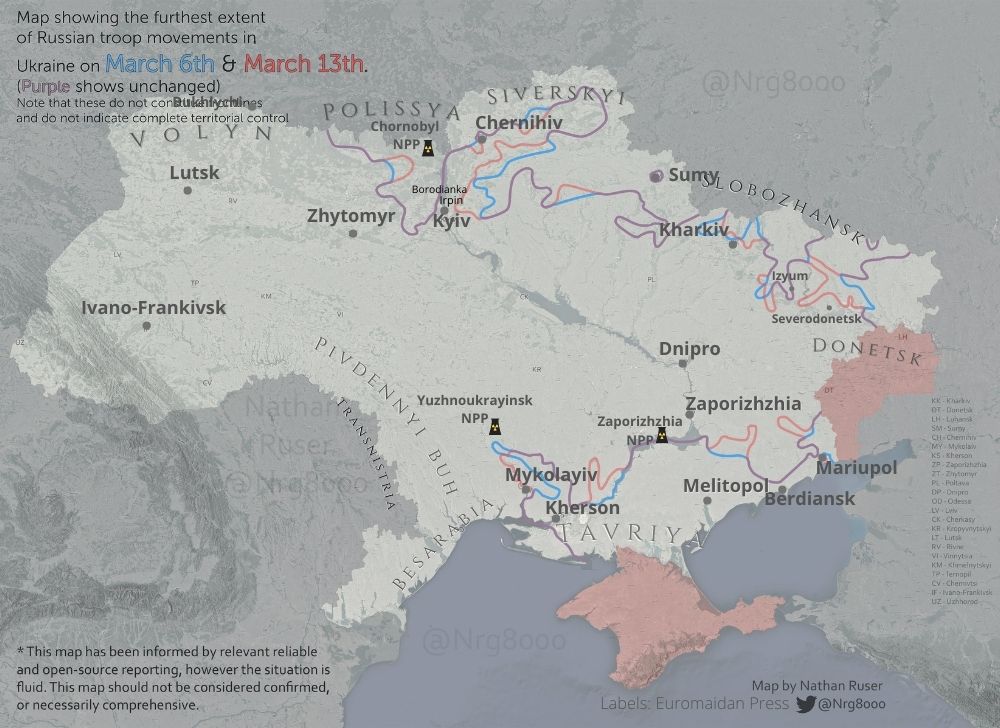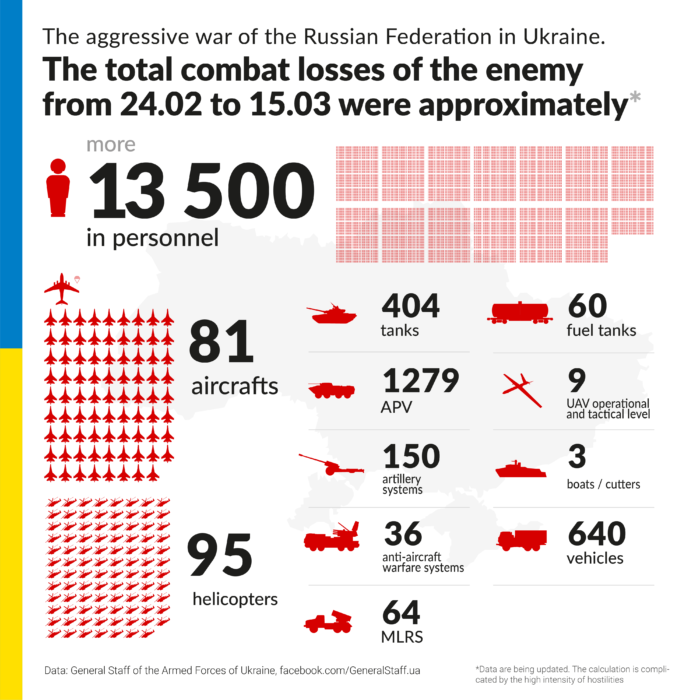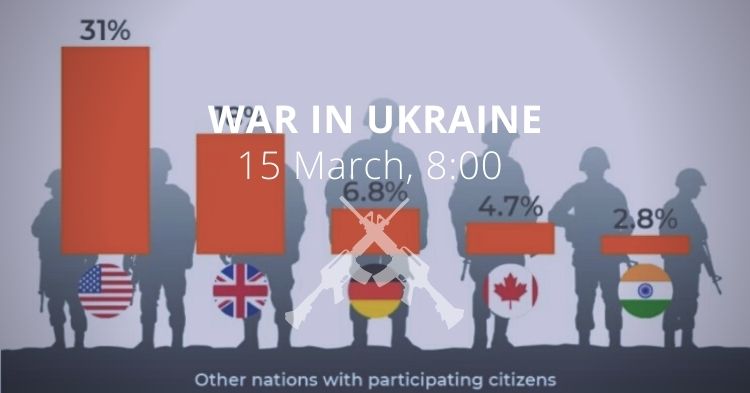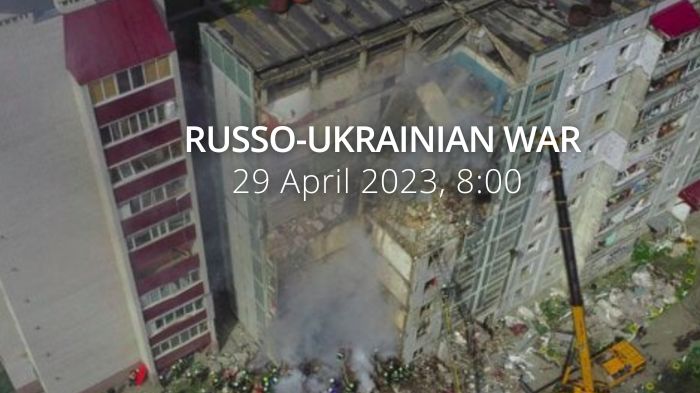Morning report day 20 – March 15
The report is based on media reports, expert analyses and official information posted online.
BTG: Battalion Tactical Group, approximately 600–800 officers and soldiers, of whom roughly 200 are infantrymen, typically equipped with roughly 10 tanks and 40 infantry fighting vehicles.
Situation
According to information from the General Staff as of 06.00 15.03.2022, supplemented by its [midnight assessment]:

“The twentieth day of the heroic resistance of the Ukrainian people to the Russian military invasion began.
[The enemy continues the offensive operation against our State.]
Status, position, and nature of actions of the defense forces without significant changes.
The Armed Forces of Ukraine are inflicting devastating blows on groups of troops and the rear infrastructure of the occupiers.
The groups of the occupying forces involved in the offensive did not have significant success in all areas of advance. The main efforts continue to be focused on maintaining the occupied borders.
[The enemy continues to use aircraft to support ground forces and destroy military and civilian infrastructure in Ukraine.]
[The formation of additional occupation units to conduct hostilities on the territory of Ukraine continues. According to available information, the enemy plans to strengthen the grouping of troops of the Russian Armed Forces in the Kharkiv direction.]
[In the Volyn direction, there is a high probability of provocations at Belarusian facilities in order to involve the Armed Forces of the Republic of Belarus in the conflict.]
[In the Polissya direction, the occupying forces are fighting in the areas of the settlements of Poliske, Kropyvnya, Zakharivka, Olyva, Sloboda, Kukharska, Zhovtneve, Ozershchyna, Lypivka, Kopyliv, Motyzhyn, Buzova, Horenychi, Bucha, and Demydiv.]
[In the Siverstky direction, the enemy is fighting in the areas of the settlements of Lyubech, Slavutych, Kovryta, Zolotynka, Mena, Branytsia, Kalita, Bogdanivka, Lukash, Romny, Nedrigailiv.]
[Russian enemy does not carry out active offensive actions. It carries out regrouping of troops, improves the logistics system in order to prepare and resume the offensive in the direction of Brovary.]
[In the Slobozhansky direction, the enemy does not stop trying to surround Sumy and conducts hostilities in the areas of Svatove, Izium, Hrushevakha, Petrivske, Husarivka, Balakliya, Lyman, Malynivka, Kochetok, Bezruky, Oleksandrivka, Velyka Pysarivka, Tarashivka, Nedrygailiv, Romny, Talalaivka.]
[The enemy does not carry out active offensive actions. In order to strengthen terrorist groups in the areas of Sumy, Okhtyrka, Kharkiv, and Izium, regroups troops and consolidate on the captured borders. At the same time, there are problems with the supply of ammunition to the firing positions.]
[In order to replenish units of the 6th General Army, conscripts are urged to move to contract service.]
[In the Donetsk and Tavriya directions, the occupiers are fighting with certain forces in the areas of the settlements of Borova, Ternove, Novokrasnyanka, Luhanske, Horlivka, Panteleimonivka, Mykilske, Huliaipole, Orikhiv, and Kamyanske.]
[In the Avdiivka direction in the area of settlement Kamyanka, during the reconnaissance battle, the occupiers suffered significant losses and were forced to withdraw.]
[In the Volnovakha direction, the enemy does not stop trying to breakthrough in the direction of Vuhledar.]
The enemy is trying to capture Mariupol. Ukrainian soldiers successfully repulsed the attacks of the invaders. The total losses of the enemy amounted to about 150 people, 2 tanks, 7 infantry fighting vehicles and one armored personnel carrier. After the losses, the occupiers stopped the offensive and retreated.
24:00 EET Fighting continues in all directions. The most active in Donbas and for Mariupol. All Russian attempts to advance there were unsuccessful, Russians retreated with losses – General Staff
📷 Mariupol today, experiencing more air and artillery strikes pic.twitter.com/a3IqdrYm4A
— Euromaidan Press (@EuromaidanPress) March 14, 2022
[Ukrainian] Artillery and aircraft inflicted fire damage on the accumulation of military equipment and enemy columns on the advance routes. According to the available information, as a result of the artillery fire, 12 units of motor vehicles were destroyed.
The battalion also suffered tactical groups from the 336th Separate Marine Brigade and the 11th Separate Assault Brigade.
[In the Pivdennyi Buh directions, the enemy is trying to gain a foothold in the areas of Tomyna Balka, Nadezhdivka, Kiselivka, Pervomaiskе, Mykhailo-Larine, Ulyanovsk, Pisky, Dobre, Snihurivka, Arkhangelske, Zagradivka, Osokorovka, Beryslav, Kakhovka.]
No signs of preparation for a naval landing operation were found in the Black Sea and Azov operational zones.
During the past 24hrs, four helicopters, one plane and a fighter shot down an enemy cruise missile were hit by a group of the Air Force of the Armed Forces of Ukraine.
According to the available information, due to the inability to maintain the functioning of institutions and organizations to ensure the livelihood of settlements in the temporarily occupied territories of ORDLO (certain areas of Donetsk and Luhansk Oblasts), the occupiers are forced to suspend the mobilization of communal workers.
Uses a network of health care facilities in the temporarily occupied territories of Ukraine to treat wounded personnel.
The moral and psychological state of the enemy remains low, which leads to the refusal of servicemen of the Russian Armed Forces to carry out the orders of the command. Also, according to available information, mobilized residents from the occupied territory of some districts of Luhansk oblast are sent to replenish the losses of active units of the Russian occupation forces involved in hostilities in Ukraine.”
Russian soldiers have massively refused to participate in the war in Ukraine, Guildhall news agency reports.
The agency has gotten access to photographs of reports written by Russian soldiers from the 41 Army of the Russian Federation, who participated in the military actions on Ukrainian territory. Among the reasons for refusal soldiers listed unwillingness to be used as “cannon fodder,” lack of understanding why they were deployed to Ukraine, lack of technical supplies, lack of coordination of actions, as well as lack of communication both within the unit and with the command. The civil protests and demonstrations by Ukrainians had made an impact.
According to Ukrainian intelligence, in connection with the refusal of some officials of the 76th Assault Division (Pskov) (Russian Airborne Troops), including deputy commanders, to carry out criminal orders to conduct hostilities in Ukraine, the Russian military police detained four servicemen of the division.
According to British Defence Intelligence, (last 24 hours):
- Multiple demonstrations have taken place over several days in the Russian-occupied cities of Kherson, Melitopol, and Berdiansk.
- Reporting suggests that Russia may seek to stage a “referendum” in Kherson in an attempt to legitimize the area as a “breakaway republic” similar to Donetsk, Luhansk, and Crimea. Further protests were reported in the city yesterday with Russian forces reportedly firing warning shots in an attempt to disperse peaceful protesters.
- Russia has reportedly installed its own mayor in Melitopol following the alleged abduction of his predecessor on Friday 11 March. Subsequently, the Mayor of Dniprorudne has also reportedly been abducted by Russian forces.
- Russia is likely to make further attempts to subvert Ukrainian democracy as it attempts to consolidate political control of Ukraine.
- Russian accusations that Ukraine intends to use chemical and biological weapons continue. We have seen no evidence to support these accusations.
- Russia could possibly be planning to use chemical or biological weapons in a ‘false-flag’ operation. Such an operation could take the form of a faked attack, a staged ‘discovery of agents or munitions, or fabricated evidence of alleged Ukrainian planning to use such weapons. A ‘false-flag’ attack would almost certainly be accompanied by extensive disinformation to complicate attribution.
- Intelligence suggests Russia likely intended to use ‘false-flag’ operations to justify their initial invasion of Ukraine on 24 February.
As of 15.03.2022 morning, the approximate losses of weapons and military equipment of the Russian Armed Forces from the beginning of the war to the present day:

- personnel – more than 13,500 people (+1000),
- tanks – 404 units (+15),
- armored combat vehicles – 1279 units (+30),
- artillery systems – 150 (no change),
- multiple rocket launchers – 64 (no change),
- air defense means – 36 (+2),
- aircraft – 81 (+4),
- helicopters – 95 (+5);
- automotive technology – 640 (+23),
- light speedboats – 3 units (no change),
- fuel and lubricant tanks – 60 (no change),
- UAV operational and tactical level – 9 (+1).
Humanitarian
According to UNHCR 2,824,784 refugees have been registered as of 13 March.
The UN says that so far Poland has taken in 1,720,227 refugees, Hungary 255,291, Slovakia 204,862, Moldova 330,217, Romania 412,856, Russia 131,365, and Belarus 1,226.
The reported number of refugees in both Moldova and Romania has increased with 551,408 overnight indicating faulty reporting until now. The new updated statistics have for whatever, reason left out the 304,156 people that previously had been listed as having moved on to others in Europe.
“Ukraine continues working on humanitarian corridors from besieged cities and places on the verge of a humanitarian catastrophe,” the Centre for Defence Strategies reports.
“More than 1,700 people were evacuated (Monday] through humanitarian corridors in the Luhansk Oblast. For the fourth day, attempts continue to unblock the movement of a convoy with 90 tons of humanitarian cargo trying to reach Mariupol (now 60 kilometers away). It was blocked by shelling from Russian troops in violation of the Geneva Convention and previous written agreements.
The number of civilians killed in Mariupol has already exceeded 2,500 people (City Council). There was no evacuation from the Sumy Oblast, where Russian troops compromised the ceasefire, and in the Kharkiv Oblast because of a destroyed bridge.
The occupants blew up the bridge between Enerhodar (Zaporizhzhia NPP) and Zaporizhzhia. As a result, any transportation, including humanitarian convoys and evacuation of people, is temporarily impossible.
In Chernihiv, 70% of the population is without electricity. The occupants bombed one of the pumping stations that supply water to the city and an underground gas storage facility in the Chernihiv region. Four people died. Russian troops also shelled Chernihiv Polytechnic National University.
In Zaporizhia, sewage treatment plants were destroyed, and sewage entered the Dnipro River.
At night, a residential area in Kyiv was shelled. A Russian shell hit a high-rise building. Two people died, and three were hospitalized in the collapse of the residential building. The remnants of a Russian cruise missile shot down by Ukrainian air defenses fell in another district of Kyiv, killing one person and wounding six.
https://twitter.com/EuromaidanPress/status/1503375259084468231
In the morning, the Russian occupants fired on the Antonov factory and in the evening, the large Lavina Mall shopping center. Despite the night shelling, the situation in Kyiv is stable. The metro trains are operating, and more than 30 markets are working in Kyiv, in addition to chain stores, to provide food.
A TV tower near Rivne was damaged as a result of an airstrike, 9 people died and 9 were injured.
In Kherson and Melitopol, despite the danger, local rallies continue against the Russian military, which has temporarily taken over these cities. Occupiers traditionally blocked communications and the Internet in an attempt to stop the demonstrations.”
Russians opened fire on civilians at a peaceful rally in Kherson. Acc to local journalist Ryzhenko, there were shots in the legs; Russian troops shot at least one man in the leg with a rubber bullet,–UkrPravdapic.twitter.com/Y9yxOwC3LK
— Euromaidan Press (@EuromaidanPress) March 13, 2022
Legal
For the fourth day, attempts continue to unblock the movement of a convoy with 90 tons of humanitarian cargo trying to reach Mariupol (now 60 kilometers away), the Centre for Defence Strategies reports.
It was blocked by shelling from Russian troops in violation of the Geneva Convention and previous written agreements. The number of civilians killed in Mariupol has already exceeded 2,500 people (City Council).
Russia disrupts humanitarian convoys and evacuation from the war zone in Ukraine
The General Staff of Ukraine reports that Russian forces:
- Continue to launch missile and bomb strikes, shell artillery, and tanks of civilian infrastructure and settlements.
- Continue to insidiously use civilian infrastructure to equip firing positions, deploy weapons and military equipment.
Support
The Estonian parliament demands a no-fly zone above Ukraine. On 14 March, it adopted a resolution addressed to the parliaments of other EU member states and NATO, as well as to the parliaments of other countries regarding Russia’s aggression against Ukraine, Estonian World reports.
European Union member states have agreed on the fourth package of sanctions against Russia following its invasion of Ukraine, the office of the French EU presidency has announced, RFERL reports.
“The French presidency said revoking Russia’s ‘most-favoured-nation\ trade status would be part of the package, a move that could open the door to the bloc banning or imposing punitive tariffs on Russian goods and putting Russia on the same level with North Korea or Iran.”
Admiral Stavridis (Ret.), the 16th Supreme Allied Commander at NATO, calls for more military support to Ukraine. In an article in Time, he argues that
“we need to increase the level of intelligence we are providing, ensuring it is of true tactical value and arrives in real-time. The Ukrainians need cyber protection and overwatch.”
Regarding the request for No-Fly Zone, he recommends providing Ukraine with the sensors and weapons they need to create such a zone rather than sending US-NATO assets into combat.
Finally, we should continue to pursue the idea of providing combat aircraft as it would provide a morale boost to the Ukrainians; and send a signal to Putin that we are not going to back down, he says. Alongside the aviation materials, he argues that there are
“plenty of ground systems that should continue to flow into Ukraine—Javelins, TOWs, small arms ammunition, sniper systems, heavy machine guns, rocket-propelled grenades—all of that seems to be moving swiftly and we must keep the pace up. All of this must get into Ukrainian hands in days, not long weeks and months. We are in a logistic race with Russia, and it is one we can and must win.”

20,000 reportedly join Ukraine’s foreign legion
“On February 27, just three days after Russia invaded Ukraine, Ukrainian President Volodymyr Zelenskyy put out a call for foreign volunteers to join the Ukrainian armed forces, announcing the creation of an international legion”, Aljazeera reports. “A day later, the president signed a decree waiving visas for any foreign nationals wishing to join the Ukrainian army, while the foreign affairs ministry launched a website providing details about how to apply. In recent days, the Ukrainian authorities have said that some 20,000 people from 52 countries have applied to join the legion.”
New developments
- Negotiations with Russia are to continue on Tuesday, Ukraine’s President Volodymyr Zelenskyy said late on Monday, Reuters reports.
- There are presently four separate back-channel efforts underway to start negotiations by the leaders of France, Israel, Türkiye, and Germany. But so far, Putin refuses to engage in any serious negotiation.
- Russian Patriarch Kirill’s full-throated blessing for Moscow’s invasion of Ukraine has splintered the worldwide Orthodox Church and unleashed an internal rebellion that experts say is unprecedented, Reuters reports. More than 280 priests belonging to the Russian Orthodox church have signed an open appeal distancing themselves from the war and calling for reconciliation and ending the war.
Assessment
The Institute for the Study of War has made the following assessment as of Monday 23:00 (Kyiv time):
“Russian forces made small territorial gains in Luhansk Oblast on March 14 but did not conduct any major attacks toward Kyiv or in northeastern Ukraine.
Russian forces continue to assemble reinforcements and attempt to improve logistical support in both the Kyiv and southern operational directions.
Ongoing Russian efforts to replace combat losses with both Russian replacements and non-Russian sources, including Syrian fighters and the Wagner Group, are unlikely to enable Russia to resume major offensive operations within the coming week.
Key Takeaways
- Russian forces conducted several limited attacks northwest of Kyiv on March 14, unsuccessfully attempting to bridge the Irpin River.
- Russian forces did not conduct offensive operations east of Kyiv and continued to prioritize improving logistics and reinforcing combat units.
- The continued ability of Ukrainian forces to carry out successful local counterattacks around Kharkiv indicates that Russian forces are unlikely to successfully bypass Kharkiv from the southeast to advance toward Dnipro and Zaporizhzhia in the near term.
- Russian and proxy forces continue to achieve slow but steady territorial gains in Donetsk Oblast after initial failures in the first week of the Russian invasion.
- Ukrainian forces halted Russian attacks from Kherson toward Mykolayiv and Kryvyi Rih on March 14.
- Russia will likely deploy small units of Syrian fighters to Ukraine within the week and is confirmed to have deployed private military company (PMC) forces.
- Russian and Belarusian forces increased their activity near the Ukrainian border in the last 24 hours in a likely effort to pin down Ukrainian forces but likely do not have the capability to open a new axis of advance into western Ukraine.
- Russia and China deny that Russia seeks military aid from China and claimed that Russia does not need additional military support to complete its objectives in Ukraine.”
[…By ] analysing three maps depicting the operational picture, including one released by the UK’s Ministry of Defence (MoD) and two curated by open-source investigators – the Twitter account Jomini of the West and Konrad Muzyka’s Ukraine Conflict Monitor – it is apparent that Russian forces are making progress. […]
Though it seems clear that the initial Russian plan was based around a swift coup de main against Kyiv while the bulk of the Ukrainian army was pinned in the east opposite Donetsk and Luhansk, this is unlikely to remain the case.
Even under best-case assumptions (from a Russian perspective), it is unlikely that Kyiv will be taken soon. However, it is worth considering that there is a second Ukrainian centre of gravity – alluded to by Vladimir Putin in his pledge to ‘demilitarise’ Ukraine – the regular Ukrainian army, most of which remains near Donetsk and Luhansk under the aegis of the Joint Forces Operation (JFO).
The position of this force is looking increasingly precarious as Russian forces advance to encircle it on three axes.
Russian forces of the 58th Combined Arms Army and 22nd Army, pushing north from Crimea, have commenced assaults on Beryslav along the Dnieper, and appear likely to link up at Polohy with Russian separatist forces and the Eighth Combined Arms Army advancing from Donbas.
Elements of the First Guards Tank Army and Sixth Combined Arms Army advancing past Kharkiv also appear to have largely eschewed attempts to take the city – focusing instead on reducing it with artillery while bypassing it as they advance south and west past Poltava, cutting the JFO off from escaping northwards.
Finally, in the southwest, Russian forces of the 20th Guards Motor Rifle Division appear similarly intent on bypassing Mykolaiv but, notably, may not be advancing on Odesa. Instead, they appear to be advancing north, which could suggest a desire to seize the western banks of key crossing points over the Dnieper.
Viewed in conjunction, these advances present a troubling picture whereby the Ukrainian forces opposite Donetsk and Luhansk are at risk of encirclement on the eastern side of the Dnieper.
If this is indeed the focus of Russia’s approach, then the emphasis on Russia’s ability to take major cities as a metric of success will have been an analytical error, as Russia appears more intent on pinning Ukrainian forces in cities like Kharkiv while it bypasses them. Indeed, preparations for an amphibious assault on Odesa may have been a feint, given that the ground forces such an assault could have linked up with appear to be moving north.
The elimination of a large part of the country’s regular armed forces could lead Russia to claim it had achieved its goal of demilitarising Ukraine.
For Ukraine, this represents a critical moment. The encirclement and destruction of a large part of the country’s regular armed forces could represent a victory condition for Russia in two ways. […]
To hold Kyiv and other major cities at the cost of allowing the forces of the JFO to be encircled could prove disastrous.
Even if Ukraine will not collapse following the encirclement and destruction of the JFO, the elimination of this force could lead Russia to claim it had achieved its goal of demilitarising Ukraine and would enable an annexation of Donetsk and Luhansk at a minimum.
Finally, it is worth considering the importance of regulars in any post-war campaign mounted against Russian occupation. Compound warfare, involving both regular and irregular formations, tends to have a good track record of eventually defeating occupation by a stronger force, with examples including the Peninsular War and Chinese Civil War. It is, in many ways, preferable to a pure insurgency strategy.
While irregulars can raise the costs of occupation and harass supply lines, they require a regular force to both pin the attention of an occupier and conduct eventual counteroffensives. The survival of the forces currently in the east of Ukraine would therefore be critical to an insurgency’s success.”
In the “Fog of War,” with conflicting information and assessments, one will find both pessimistic outlooks and positive analyses.
In an article from the Daily Mail today, a senior UK source is quoted of saying:
“Ukraine has Russia on the run. It is running out of manpower and running out of energy. As long as we keep pressing, they’ve got ten to 14 days before reaching their culminating point. That’s when the strength of Ukraine’s resistance should become greater than Russia’s attacking force.
By that time, they may struggle to make any significant progress – while finding it difficult to hold ground, according to the latest intelligence. […] Despite another day in which bombs rained down on Ukrainian cities including Kyiv and Kharkiv, resistance to the onslaught has seen the invasion fall behind schedule, allies of Vladimir Putin admitted for the first time on Monday. And American officials said the ground advance, now in its third week, had largely stalled.”
At the end of the day, logistics will define the outcome.
Russia is recruiting, reinforcing, resupplying, and reorganizing in preparation for a renewed effort to achieve its strategic goals. Additionally, we must expect the Russian Air Force to increase its operations over Ukraine in the week to come.
The present situation and the limited number of offensive operations must be seen as a temporary lull in the offensive.
Ukraine is doing the same.
In an address by Defence Minister Oleksii Reznikov on 14 March, he stressed that
“the strengthening of air and missile defence is now a top priority. We are working around the clock to obtain respective support or purchase the required weaponry. Frankly speaking, it is not easy. Because not everyone who makes such decisions has the same willpower as the Ukrainian people.”
The international community urgently needs to increase its defense aid to Ukraine to ensure that it does not meet the culmination point before Russia.








